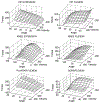Maximum voluntary joint torque as a function of joint angle and angular velocity: model development and application to the lower limb
- PMID: 17485097
- PMCID: PMC6820133
- DOI: 10.1016/j.jbiomech.2007.03.022
Maximum voluntary joint torque as a function of joint angle and angular velocity: model development and application to the lower limb
Abstract
Measurements of human strength can be important during analyses of physical activities. Such measurements have often taken the form of the maximum voluntary torque at a single joint angle and angular velocity. However, the available strength varies substantially with joint position and velocity. When examining dynamic activities, strength measurements should account for these variations. A model is presented of maximum voluntary joint torque as a function of joint angle and angular velocity. The model is based on well-known physiological relationships between muscle force and length and between muscle force and velocity and was tested by fitting it to maximum voluntary joint torque data from six different exertions in the lower limb. Isometric, concentric and eccentric maximum voluntary contractions were collected during hip extension, hip flexion, knee extension, knee flexion, ankle plantar flexion and dorsiflexion. Model parameters are reported for each of these exertion directions by gender and age group. This model provides an efficient method by which strength variations with joint angle and angular velocity may be incorporated into comparisons between joint torques calculated by inverse dynamics and the maximum available joint torques.
Figures



References
-
- Audu ML, Davy DT, 1985. The Influence of Muscle Model Complexity in Musculoskeletal Motion Modeling. Journal of Biomechanical Engineering 107, 147–157. - PubMed
-
- Cabri JM, 1991. Isokinetic strength aspects of human joints and muscles. Crit Rev Biomed Eng 19, 231–259. - PubMed
-
- Caldwell GE, Adams WB, and Whetstone MR, 1993. Torque/Velocity Properties of Human Knee Muscles: Peak and Angle-Specific Estimates. Canadian Journal of Applied Physiology 18, 274–290. - PubMed
-
- Chow JW, Darling WG, Hay JG, and Andrews JG, 1999. Determining the Force-Length-Velocity Relations of the Quadriceps Muscles: III. A Pilot Study. Journal of Applied Biomechanics 15, 200–209.
Publication types
MeSH terms
Grants and funding
LinkOut - more resources
Full Text Sources
Other Literature Sources

